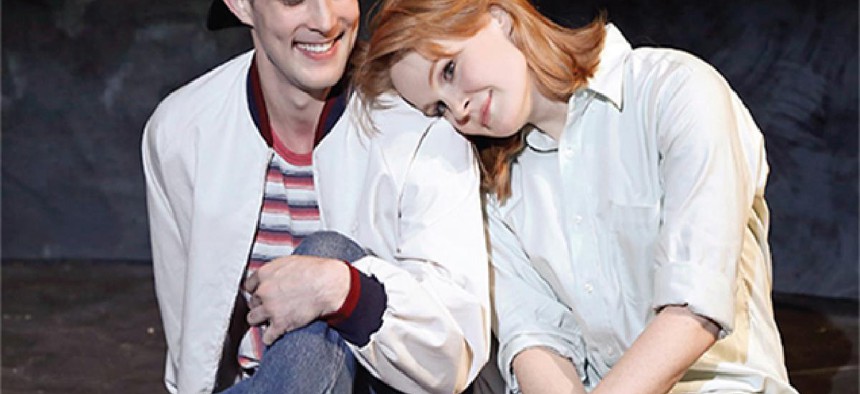Arts Groups Diversify Funding

With a two-cast member musical already planned for their 15th season, Keen Company, a nonprofit off-Broadway theater troupe in Midtown, reviewed fundraising projections for the coming year.
“The necessity of having to look at things a little bit smaller from a cast perspective ended up being a plus,” said Jonathan Silverstein, who directed the plays. Actresses in both shows, “John and Jen” and “A Walk in the Woods,” were nominated for Drama Desk Awards. But despite the laurels, Keen, now in its 16th season, needed to address the issue of finding funding.
“It’s really been about how we’ve been able to creatively find different ways to get private grant money,” Silverstein said. “As we grow, we realize we can’t rely on public grants.”
Complaints of stagnant or disappearing public funding reverberate throughout the New York City creative nonprofit community; public funds have either been cut or cannot keep up with inflation. Funding from the National Endowments for the Arts for New York City nonprofits dropped 15 percent since 2008. Funding from the New York City Department of Cultural Affairs decreased 16 percent during the same time period, and funding from the New York State Council for the Arts fell 49 percent, all numbers accounting for inflation.
This volatility in government support has forced nonprofit arts organizations to pursue private funding options. Across New York City the number of arts and culture nonprofits rose 54 percent in the last 10 years despite significantly less grant money, according to a June report by the Center for an Urban Future called “Creative New York.”
“City and state funders are telling us to diversify our funding base,” said Lynn Lobell, grants and resource director at the Queens Council for the Arts, whose regrant program saw a 28 percent drop in funding from 2008 to 2015 – mostly due to government belt-tightening. “It makes sense.”
To remain financially secure, Lobell advocates for an even distribution among public, corporate, foundation and individual funding. “You want public grants to be the least because you never know when you’ll be cut,” she said.
Following the recession, corporate donations for arts organizations dwindled and have yet to return to previous levels. “There aren't enough audience members to attract corporate sponsorships,” said Ginny Louloudes, executive director of The Alliance of Resident Theaters/New York. “There’s very little corporate money out there for philanthropic giving.”
So creative nonprofits have looked to private donations to patch holes left by shifting funding bases. This typically comes in the form of either donations from affluent benefactors or crowdfunding campaigns.
Harlem Stage, a nonprofit that supports artists of color, recently moved away from relying on government money to a “private funding model” where big donors are pursued.
“It’s much more labor intensive,” said Patricia Cruz, the group's executive director, who says her staff constantly works on cultivating benefactors.
For creative nonprofits like Harlem Stage that seek wealthy private donors, the best place to search for donors is within established audiences, encouraging those with an interest in art to financially support it. Then, by offering certain perks, benefits, and special access to artists and exhibits, nonprofits can entice audience members to join their boards.
Many nonprofits, following the slide in government funding, felt they already exhausted this option or found themselves without the resources to doggedly pursue philanthropists. As a result, many agencies embarked on crowdfunding campaigns via platforms like Indiegogo or Kickstarter.
In New York City, creative projects have raised $105.3 million on Kickstarter since its inception in 2009; that’s 2 percent more than city cultural organizations received from the NEA during the same time span, according to the Center for an Urban Future. This doesn’t mean, however, that crowdfunding campaigns guarantee success without much effort.
“There is constant follow-up and follow through with your donors,” said Lobell, who specializes in grassroots fundraising like crowdfunding. “One might assume, if they are unfamiliar with this process, that it is as easy as pressing a button, but indeed you have to set goals and keep up with them until they are met or you will not be successful.”
“My experience with nonprofits has been if they need $10,000 and get $7,500, they can use that and ask for the rest from someone else,” Louloudes said.
According to those experienced in the world of crowdfunding, the best way to secure all of a project’s funds involves focusing campaigns on specific projects. Donors don’t want to pay the electricity bill but instead want to know their money will go to a creative pursuit.
Louloudes says people who tighten their purse strings at the thought of donating to a creative nonprofit are acting at a detriment to their city. “If you don't have a city with a robust arts ecosystem, you're not going to survive. What's the difference between living in Newark and New York? The arts.”
NEXT STORY: The Three A's of a Successful Agency
